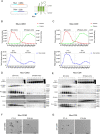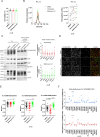Homosalate boosts the release of tumour-derived extracellular vesicles with protection against anchorage-loss property
- PMID: 35790086
- PMCID: PMC9253888
- DOI: 10.1002/jev2.12242
Homosalate boosts the release of tumour-derived extracellular vesicles with protection against anchorage-loss property
Abstract
Eukaryotic cells, including cancer cells, secrete highly heterogeneous populations of extracellular vesicles (EVs). EVs could have different subcellular origin, composition and functional properties, but tools to distinguish between EV subtypes are scarce. Here, we tagged CD63- or CD9-positive EVs secreted by triple negative breast cancer cells with Nanoluciferase enzyme, to set-up a miniaturized method to quantify secretion of these two EV subtypes directly in the supernatant of cells. We performed a cell-based high-content screening to identify clinically-approved drugs able to affect EV secretion. One of the identified hits is Homosalate, an anti-inflammatory drug found in sunscreens which robustly increased EVs' release. Comparing EVs induced by Homosalate with those induced by Bafilomycin A1, we demonstrate that: (1) the two drugs act on EVs generated in distinct subcellular compartments, and (2) EVs released by Homosalate-, but not by Bafilomycin A1-treated cells enhance resistance to anchorage loss in another recipient epithelial tumour cell line. In conclusion, we identified a new drug modifying EV release and demonstrated that under influence of different drugs, triple negative breast cancer cells release EV subpopulations from different subcellular origins harbouring distinct functional properties.
© 2022 The Authors. Journal of Extracellular Vesicles published by Wiley Periodicals, LLC on behalf of the International Society for Extracellular Vesicles.
Conflict of interest statement
The authors declare no conflict of interest.
Figures






References
-
- Auld, D. S. , & Inglese, J. (2016). Interferences with Luciferase Reporter Enzymes. In S. Markossian (Eds.) et. al., Assay Guidance Manual Eli Lilly & Company and the National Center for Advancing Translational Sciences, 1(Md), 1–13. Available: http://www.ncbi.nlm.nih.gov/pubmed/27478246 - PubMed
-
- Birmingham, A. , Selfors, L. M. , Forster, T. , Wrobel, D. , Kennedy, C. J. , Shanks, E. , Santoyo‐Lopez, J. , Dunican, D. J. , Long, A. , Kelleher, D. , Smith, Q. , Beijersbergen, R. L. , Ghazal, P. , & Shamu, C. E. (2009). Statistical methods for analysis of high‐throughput RNA interference screens. Nature Methods, 6(8), 569–575. 10.1038/nmeth.1351 - DOI - PMC - PubMed
Publication types
MeSH terms
Substances
Grants and funding
LinkOut - more resources
Full Text Sources
Research Materials
Miscellaneous

